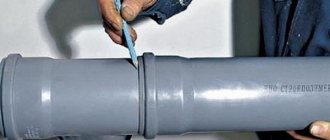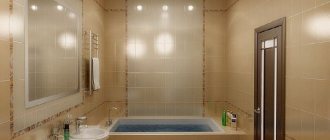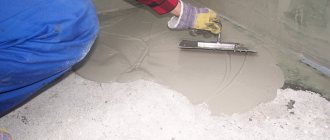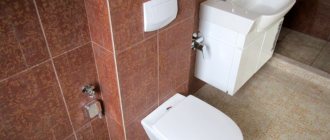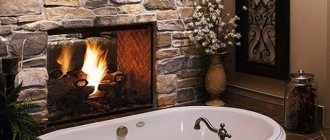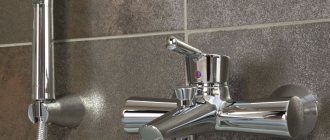Any original idea for decorating a bathroom can end in failure if risers and parts of various sewer lines left by the builders in the most visible place are visible from the walls or floor.
Because of this, many owners wonder how to hide pipes in the bathroom. Only complete or partial disguise of such unsightly elements can save the situation. This will help you design your bathroom the way you want.
Why do you need to hide sewer and water pipes?
Any utilities, in particular water supply, sewerage, gas pipelines, are laid into the house using a pipeline. It transports gas to the kitchen, water to the bathroom and toilet. Accordingly, in each of these rooms there are pipes that interfere with the beautiful interior design. To give a neat look to the room, you need to decorate or disguise them.
Before hiding the pipes, you need to decide what material will be used to carry out the event.
Pros and cons of pipe sealing
A clear advantage is the decorative design of the room, aesthetics, the absence of unnecessary details in the interior, the appearance of additional space for placing household items on it or inside it. However, there are also disadvantages: there is no direct access to the pipeline, so in the event of a breakthrough it is necessary to completely or partially dismantle the camouflage.
It is not entirely correct to choose products based on aesthetic components, since they must also have other properties.
Pipes behind the screen
The development of fashion is noticeable even in the interior of the bathroom. And for lovers of hi-tech style, a special screen is perfect for masking pipes. It will not only merge with the overall design of the room, but will also serve its owner well. Traditionally, the screen is installed together with plastic panels. And together this design forms, as it were, a false wall, behind which the pipes are hidden, a stylish screen provides access to communications
, both for inspection and repair. By the way, such mirror screens have become very popular recently. Moreover, in a bathroom with a large area you can install such a full-length mirror.
Another screen option can be called sanitary roller shutters . These are small plastic roller blinds that look perfect both on plastic panels and on painted walls and tiled walls. Such a screen will look advantageous in all stylistic solutions.
And if the pipes in the bathroom do not run very high, then it is not necessary to cover the entire wall with plastic with a screen, but 70-90 centimeters from the floor is enough. This will give you an additional shelf for numerous jars of creams, shampoos, gels and conditioners. Unfortunately, special screens also have minor drawbacks - they take away several centimeters from the bathroom area.
What is important to know before installation
Before starting work, it is necessary to reduce the likelihood of an emergency, seal all connections: bends, turns, all joints. If the pipes are old, you can completely replace them. You also need to think about how to provide access to meters, valves and dampers after installing camouflage structures, and leave space for installing special inspection (inspection) doors.
The design should not clutter up the small area of the room, so you should choose materials that do not require a massive frame.
Basic requirements for sealing materials
The material must meet the following criteria:
- Resistance to humidity and temperature changes
- Lightness, so as not to overload the space of the room
- Easy to install
- Resistance to household chemicals used during cleaning
- Affordable price
- Long service life
The material with which the water pipes will be closed must be resistant to moisture.
Preparation of communications
Before starting landscaping work, you should check the serviceability of the sewerage and water supply.
Requirements for sewer pipes:
- They must be without the slightest cracks, otherwise replace them immediately;
- No specific sewer smell. If there is one, then additionally treat the joints and service hatches along their perimeter with silicone sealant;
- The places where the sewerage passes through the upper and lower ceilings must be tightly sealed with cement mortar.
Note!
In the place where the sewage system is diverted from the main pipe to the plumbing or other premises, it is advisable to install a bypass valve.
It operates on a simple principle: it does not interfere with the drainage of wastewater, but if the communications are clogged, it blocks the internal cavity of the pipe under the pressure of the reverse flow of wastewater.
Five minutes of installation and nothing will flow through your toilet from your neighbors.
It is recommended to install a valve in each sewer outlet to the sides
Requirements for the water supply system:
- Water pipes must be free of corrosion. If necessary, remove it and coat the pipeline with moisture-resistant paint. Additionally, you can put a casing made of foamed polypropylene on top - this will eliminate sudden temperature changes on the surface of the pipe and partially prevent condensation;
- Check the functionality of the water supply taps and the integrity of the threaded connections. To prevent taps from rusting or corroding when exposed to moisture, treat the moving joints with the anti-corrosion compound Nanoprotek.
Types of materials for water supply and sewerage communications
Pipes can be made of various materials: metal, plastic, metal-plastic. The type and quality of the material affects the wear resistance of the pipeline, its strength, durability, thermal conductivity, and health safety.
You need to choose products that are not prone to deformation.
Important! The desire to save money can lead to the threat of emergency situations, so the price must correspond to the quality.
Metal
Metal pipes are made of copper or steel. Copper ones are characterized by high cost, so they are not used as often as steel ones. Durable steel pipes are widely used. They are resistant to temperature and pressure changes, and stainless steel is safe for human health.
Copper ones are durable, reliable, and do not contain toxic substances.
Plastic
Polypropylene is characterized by durability (service life reaches 50 years), resistance to temperature changes, and good thermal conductivity. Polyethylene is characterized by elasticity, resistance to expansion and contraction. Suitable for cold water only. PVC is a harmful material, suitable only for technological needs.
Water supply and sewer lines can be made of plastic: polypropylene, polyethylene, polyvinyl chloride.
Metal-plastic
Metal-polymer pipes contain polyethylene and aluminum. They combine the advantages of both types, are durable, have a long service life, and are low in price. Well suited for use in a residential building. The best choice in terms of price-quality ratio.
Disadvantages include the lack of resistance to mechanical stress and direct sunlight.
What elements do not need to be hidden when masking pipes
Direct access should be left to places where the likelihood of leakage is highest: fitting - connection at the point of branching, turning, threaded fasteners, parts in which meters and filters are installed.
For quick repairs, special doors are left in such places - inspection (inspection) hatches.
How to properly hide sewer and water pipes with your own hands
How to hide pipes in the bathroom? There are several ways:
- Disguise with pieces of furniture, paint or decorate
- Install a screen made of plastic panels
- False wall - a plasterboard structure that is installed in front of the main wall, has attachment points on the ceiling and on the floor
- A box is a rectangular structure made of plasterboard, plastic or plywood. May consist of several levels
- Installation of sanitary roller shutters - a structure that operates on the principle of vertical blinds
- Tile frame
- Wall up communications into the wall.
To maintain the sanitary condition in the rooms, household chemicals are used, so the facing material must withstand contact with such products.
Painting and decor
If the task is not to make drastic changes, it is quite possible to get by with painting the pipeline. This will allow you to transform the room cheaply and without the need for major repairs. Before painting, you need to clean the surface from dust and dirt and cover it with a primer. This will provide protection against corrosion, reliable adhesion of paints and varnishes and even tone.
The optimal color is chosen to match the shade of the walls of the room.
The most suitable paint is selected for the type of material: it is better to coat metal pipes with alkyd enamel or water-dispersed paints (for example, acrylic). Alkyd paint will retain its color saturation for a long time, and household chemicals will not damage it. Water-based paint without acetone is also suitable for painting plastic pipes. In this case, applying a primer is not necessary, since the paint adheres well to the plastic.
Water-based paint is cheaper and holds color well in rooms with high humidity.
Decoration of communications is carried out using moisture-resistant polyurethane tubes, stucco molding made of plaster or polyurethane, and decorative ornaments. With stucco decoration you can not only hide unattractive interior details, but also create an interesting decoration for the room: apply patterns, give the appearance of columns, etc.
You can use decorative hardboard slabs, which are covered with melamine laminate or three-dimensional gypsum panels.
Hiding behind the furniture
The method lies in the correct selection of bathroom furniture: this includes cabinets and cabinets. Vertical communications are well hidden by a cabinet-cabinet; for this purpose, holes are made on its back wall in the shape of water supply structures. The places where pipes are supplied to the sink are usually hidden by a bedside table with swinging doors.
The convenience of such cabinets lies in storing various cleaning products and washing supplies inside them.
Screen made of plastic panels
Sliding panels are an effective method for hiding pipes in the bathroom. They are easy to install and can be disassembled if necessary. Plastic does not deform under the influence of humidity or household chemicals, so it is suitable for bathrooms and toilets.
A frame made of wood, plastic or metal profile is installed on the site of the future screen. The panels are attached to this base, and the fasteners are hidden with decorative corners.
The screen can be installed under the bath. In this way, not only communications are hidden, but also a beautiful design of the room is ensured: the panels can be with drawings and decorations.
The panels are made in a variety of colors and textures - you can always choose the right one.
Additional information: Plastic is not a fire-resistant material, so the screen should not be exposed to fire or smoke.
Box made of plasterboard or false wall
You can effectively hide a vertically and horizontally laid pipeline with a duct or false wall. The selected area is equipped with a frame made of metal profiles, after which fragments of plasterboard of the required size are attached to the base. Fasteners (screws) are coated with an anti-corrosion compound.
Drywall absorbs excess moisture, is durable and resistant to fire.
The false wall is installed in front of the main wall, completely hiding the risers and pipes. It requires leaving space for the inspection hatch by closing it with a door. Please note: the room area will be reduced.
The final finishing is carried out in accordance with the overall design, color scheme and style of the room. Equipping a bathroom with a box or false wall requires time and money.
How to close under tiles
Ceramic tiles are an excellent choice for the bathroom. It is characterized by high strength, fire resistance, chemical resistance and long color retention. Tiles come in a variety of colors and finishes, so it’s easy to choose the right one for your bathroom. The tiles are also easy to clean from dirt.
It is recommended to leave space for the door and decorate the fastening points with decorative corners.
The frame made of metal profiles is attached to the ceiling, floor and walls using special brackets. Holes are made in the tiles for self-tapping screws, which secure the tiles to the frame.
Plumbing roller shutters
An original way to disguise communications is to install roller shutters. This provides direct access to the pipeline: the shutter-type mechanism opens at any time.
Roller shutters are chosen to match the color scheme of the room and successfully highlight the loft and modern styles.
Roller shutters can be placed outside or inside frames and false walls. The interior space can be used as a cabinet for storing household items.
How to remove pipes and a riser into a niche in the wall
In some apartments, the piping system is recessed into a niche. In this case, covering the pipes with a box or panels is much easier, and the area of the room remains the same.
So, when choosing a method for masking water and sewer pipes, the following should be taken into account:
- Location of the joint, bends, turns, sealing them before starting work
- Places for installing water and sewerage meters, ensuring free access to them using inspection hatches or removable panels
- Valves must also be accessible to check their condition
- When installing the masking, do not damage the pipeline or expose it to strong mechanical stress.
- The color scheme matches the overall interior of the room
- The cladding is made from the same materials as the walls of the room; it can be supplemented with drawings and decorations with decorative items
The cladding is carried out in accordance with the material of the walls.
How to beautifully seal pipes under a sink
Another way to beautifully decorate a bathroom: communications under the sink can be closed using a pedestal. The sink is attached to it with bolts, the mixer is connected inside using flexible hoses.
Pedestals are made in a variety of shapes, shades and styles, which helps in choosing the most suitable one.
What tools and materials will be needed for the job?
Making a decorative box for a bathtub is not the most difficult, but still quite a labor-intensive process. In addition to the drywall itself, you will need a number of auxiliary materials:
- Galvanized metal profiles - the frame is assembled from them;
- Fasteners - self-tapping screws and dowel-nails for connecting elements of the supporting structure, fastening it to the surface of the floor and walls, fixing sheets of drywall;
- Silicone sealant - for treating joints with the floor;
- Serpyanka and putty - they are necessary for masking screw heads and sealing sheet joints (used when preparing the surface of a bathroom frame for painting);
- Inspection hatch – for performing maintenance.
Assembling a frame from a metal profile
The set of tools that will be needed to complete the work is not that large. It is quite possible to get by with the necessary minimum, consisting of a screwdriver with a set of bits, a hammer drill, a construction knife and metal scissors.
Necessary tools for making a box
How to hide plumbing fixtures in the bathroom
The pipes in the bathroom are connected to the bath or shower, washbasin, washing machine and toilet, if the room is combined. There are open and hidden types of wiring: in the first case, the pipeline is laid along the walls, in the second - the parts are sewn inside specially provided niches.
Properly positioned furniture helps hide communications.
With open wiring, you can build a utility cabinet that will hide various valves, filters and meters. At the same time, the free space inside is used to store cleaning supplies and household items for the bathroom. The finishing can be any, it is done according to the design of the room.
The cabinet can be decorated with a variety of designs and decorative items.
By the way, for the most beautiful design of a bathroom, the correct selection of faucets is important: they are made in different shapes, they can be made in the shape of a bird, an animal, or with lighting.
Making the frame of the box
When installing the structure frame, follow the following instructions.
- On the walls adjacent to the corner, install guides (UD profiles) that will determine the dimensions of the box. Don't forget to use a level. To attach load-bearing profiles to the wall, use European screws and dowels. If the surface is tiled, you can take metal screws 2.5 centimeters long and 3.5 millimeters in diameter. They are screwed into the seams between the tiles.
Tip: To save space in the bathroom, install profiles closer to the pipes. The minimum distance is 3 centimeters.
- If the pipes run horizontally, place the profile parallel to the floor and secure it to it.
- Start forming the outer corner. Twist a corner post from two UD profiles. Direct their shelves in different directions at right angles and connect them with small screws - “fleas”.
USEFUL INFORMATION: Leveling bathroom walls with plaster: step-by-step instructions
- Cut the CD supporting profile into pieces, the length of which will correspond to the dimensions of the structure. Attach the corner stiffener to the wall. Insert the finished profile pieces with one end into the guide installed at the first stage, and the other into the stiffening rib. Thus, both parts of the corner are connected to the profile.
- Every 50 centimeters, add jumpers, which are necessary for the subsequent fastening of PVC panels.
- The second corner profile is attached in a similar way to another wall.
Useful tips for closing sewer and water pipes
Sewer and water risers can be sealed using any of the proposed methods: installing a duct, false walls, plastic panels, a tile frame, plumbing shutters, a utility cabinet.
If you install a box, it is necessary to make it multi-level for the most efficient use of space.
If you decide to hide communications with a false wall, you can make it oblique - in this case, it is attached to the load-bearing walls at an angle. This will save part of the room area without loss.
We make the box ourselves
Men cannot always quickly decide on what they want, and therefore, your task is to promptly prompt him to the right decision. To do this, we will tell you how to hide the hidden pipework in the bathroom under the box. Think about which material is best for you:
- MDF;
- moisture-resistant plywood;
- moisture-resistant drywall;
- plastic.
These materials meet all operational requirements. Next, you need to check all pipe connections, especially if they have threads. In case of any defects, it is better to replace them. After this, you should measure the size of the future box
. Remember, the distance from the box to the pipe must be at least 3 cm. Then you need to fix the profile on the walls, and then the front face stand. Only after this can the metal structure be attached to the floor and ceiling. If the height of the frame is more than 1.5 meters, then you need to make horizontal jumpers every 70-80 cm. The frame is ready.
Now you need to cut out the material from which the box will be made and secure it with small self-tapping screws. It should be remembered that it is advisable to leave a hole in the box for the hatch, so that in case of a leak it can be easily eliminated. Next you need to carry out finishing work. Drywall, plywood and MDF lend themselves well to painting and tiling. But the plastic panels are left the same as they are - they are pleasing to the eye in themselves.
Now you have learned how to hide pipes in the bathroom. You have not only gained useful information, but also have already drawn up an approximate picture of the fantastic design of your bathroom, where not a single pipe disturbs the grace and harmony. In your mind, you have already decided on the color and material, as well as the method of masking the pipes in the bathroom, all that remains is to bring this idea to life. And on our website there is an incredible amount of excellent advice on turning an ordinary apartment or house into luxury housing. And to be the first to know all the news from the world of design, just register. You will see how with us your home turns into a fairy tale.
Conclusion
There are several effective methods for hiding sewer pipes in the bathroom, including both easy decorating methods and radical redevelopment of the entire room. Painting, decorating water supply systems, installing special cabinets and cabinets, and a pedestal for the sink will not require serious cash costs or major renovations in the bathroom, while the construction of special structures (boxes, false walls, roller shutters, tiling) will take time to install.
When developing any method, you need to think about the placement of all pipes, devices, joints and turns.
To completely bury the pipes in the wall, a change in the layout of the bathroom is required, a significant expenditure of financial resources, and it must be remembered that the occurrence of an emergency situation threatens the destruction of the structure.
Dismantling the old pipeline
The initial stage of work is the removal of all communications located in the room. To carry it out, it is necessary to turn off the water supply at the risers, and when replacing it, the water supply in the basement.
In this case, the following rules must be observed:
- Coordinate the planned work with an organization that maintains in-house water supply systems.
- Be sure to inform residents living in the apartments above and below about the upcoming replacement of communications, informing them of the exact date and time of work.
- Take all measures to promptly complete repairs to ensure that water is turned on in a timely manner.
After turning off the water, you can begin dismantling, which is carried out in several stages.
Stage 1: cutting structures and removing pipes
Having received the consent of the neighbors, you need to turn off the water in the riser, and then drain the remaining liquid in them. Then you can proceed to trimming the old pipes with a grinder. In this case, you should step back 0.5 m from the floor/ceiling of adjacent apartments to facilitate the process of connecting pipes.
When making a cut, it is important to monitor its perpendicularity, which in the future will simplify the carving on it with a die or other device.
The pipe section located in the slab is loosened with transverse blows with a hammer, after which it is knocked out (you can also use a chisel or hammer drill). To recycle old metal pipes, they can be cut into small pieces that are taken out or sold for scrap.
Stage 2: replacing shut-off valves and water drains
To replace shut-off valves at the inlet, old models are screwed together or cut off from the inlet pipe with a grinder, after which the threads are cut with a screw or other device, then the new equipment is screwed on. The screwed inlet taps are closed, after which you can turn on the water in the riser.
Water is drained from old pipes so that it does not interfere with further dismantling. The washing machine, faucets, and other water consuming appliances are disconnected from communications. All plumbing fixtures connected to the sewer are disconnected in the same way.
Stage 3: removing dowels and laying grooves
Previously, when installing pipes in the bathroom, dowels driven into the concrete with a gun were widely used for fastening to the walls.
Since such elements are extremely difficult to remove, you can remove their heads using a grinder. In this case, a smooth surface of the walls is created, thanks to which you can safely lay tiles or other finishing materials.
If the old pipes were laid in the bathroom at a great distance from the floor, it is advisable to move them to a lower height, which will allow them to be masked without resorting to gating. To do this, you will have to expand or re-punch new holes in the walls.
If it is necessary to lay channels in the walls (grooving), it is advisable to replace the metal disk inserted into the grinder with a similar part designed for working on concrete, brick and stone. If there is reinforcement in the wall, it is again replaced with a disk for metal.
